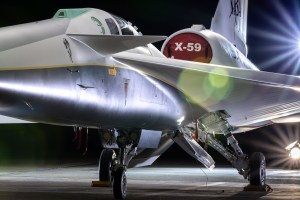A team of researchers and baseball fans at the NASA Langley Research Center in Hampton, Virginia is using baseballs to help improve computer simulations that advance aerospace technologies.
A team of researchers and baseball fans at the NASA Langley Research Center in Hampton, Virginia is using baseballs to help improve computer simulations that advance aerospace technologies. When a pitcher releases a baseball and it speeds toward the batter at 95 mph, the movement of the ball is impacted by complex forces of the air through which it is flying. But how does this relate to rocket science?
At NASA, researchers use computer programs to conduct large, complex simulations to predict how air moves over spacecraft and airplanes. The simulations, referred to as computational fluid dynamics (CFD), support both aircraft and launch vehicle programs like the Space Launch System (SLS), a rocket being designed to take astronauts and cargo to the Moon.
Kestrel, an aerodynamics computer simulation program, is a workhorse tool for analysis of the SLS rocket. “We are well versed in the use of Kestrel for our SLS work, but it can do much more. We are interested in those new features and functionality that can be leveraged for future projects,” said Dr. Brent Pomeroy, NASA aerodynamicist and avid Seattle Mariners fan.
Aerodynamics is the study of how air moves around objects, which includes rockets, airplanes, cars, or even baseballs. A baseball is a great example of an object that can be used to develop new skills – it seems to be a simple shape, but details like the seams and stitches make its aerodynamics more complex.
The NASA team is using baseballs as a way to validate computational aerodynamic techniques that can be used to advance NASA technology. It’s simpler, and avoids using sensitive data regarding actual rocket geometry.
“With a baseball, you can use trajectories to validate CFD a lot easier than aerospace vehicles that require expensive and complicated flight tests. These comparisons further develop the technology used for simulations,” added Sarah Langston, NASA experimentalist, and lifelong Chicago Cubs fan.
Pomeroy and Langston wanted to hire an intern for the project, and they selected Richard Huang, a Baltimore Orioles fan. He is in his third year at the University of Maryland studying aerospace engineering.
Using a computer scan from the Washington State University Sports Science Lab and the NASA Langley Metrology Lab, Pomeroy meticulously generated a computer file reflecting the shape of a baseball. This included not only the round shape of the ball, but also the intricate details of the seams. Pomeroy said, “it was critical that we modeled a Major League Baseball ball with utmost care to maximize simulation accuracy.”
With the computer model of the MLB baseball, the team went to work by adding four new tools to their Kestrel toolbox: surface roughness, boundary layer transition, prescribed motion, and responding-body motion.
Traditionally, CFD is done using a smooth surface. However, this team is investigating roughness effects. “Roughness simulations give a better representation of the real world and may improve the accuracy of models, reducing the cost of testing, and making human spaceflight safer,” Langston said.
Usually, simulations are executed with a fully-turbulent boundary layer. In actuality, however, laminar flow may occur. One of the benefits of laminar flow is drag reduction, which can be used to design efficient airplane wings. Introducing laminar flow to the analysis process may improve design robustness and the computational methods.
Most experiments and CFD simulations are performed with a stationary model. However, this may not be appropriate, such as the case when a rocket lifts off a launch pad. Adding prescribed motion, such as rotation of a baseball, advances the group’s technical skills. “Simulations with a moving body can be used to investigate flowfields that aren’t easily tested in a wind tunnel,” Pomeroy said.
“Once a baseball is pitched, the aerodynamics affects the ball’s movement in the air, called responding-body motion,” Huang explained. Similarities can be seen between this type of simulation and the recent Artemis I mission. For example, booster separation involves the movement of objects due to aerodynamic effects, just like a baseball.
“In aerospace, CFD is done using large supercomputers,” Pomeroy added. “We continue to advance the state of the art by leveraging software, hardware, and human resources. The result is safer next-generation flight and exploration systems that expand our knowledge of, and far beyond, Earth.”
Pomeroy added, “we have multiple goals at NASA. These include technical advances, aerospace program support, and workforce development. As part of our mission, NASA helps thousands of interns every year develop skills that they’ll take with them wherever they go.” Huang summarized, “throughout this internship, I developed my analysis and problem-solving skills while also advancing the future of spaceflight with new simulation techniques. Participating on this team is one of the most exciting early-career steps I could have taken!”
Credit: NASA



































